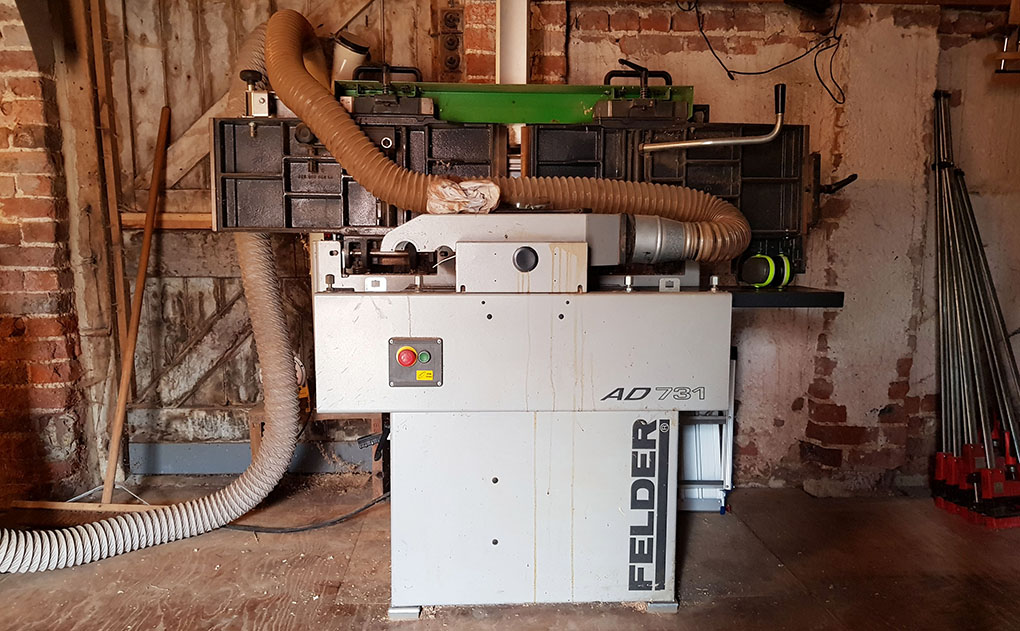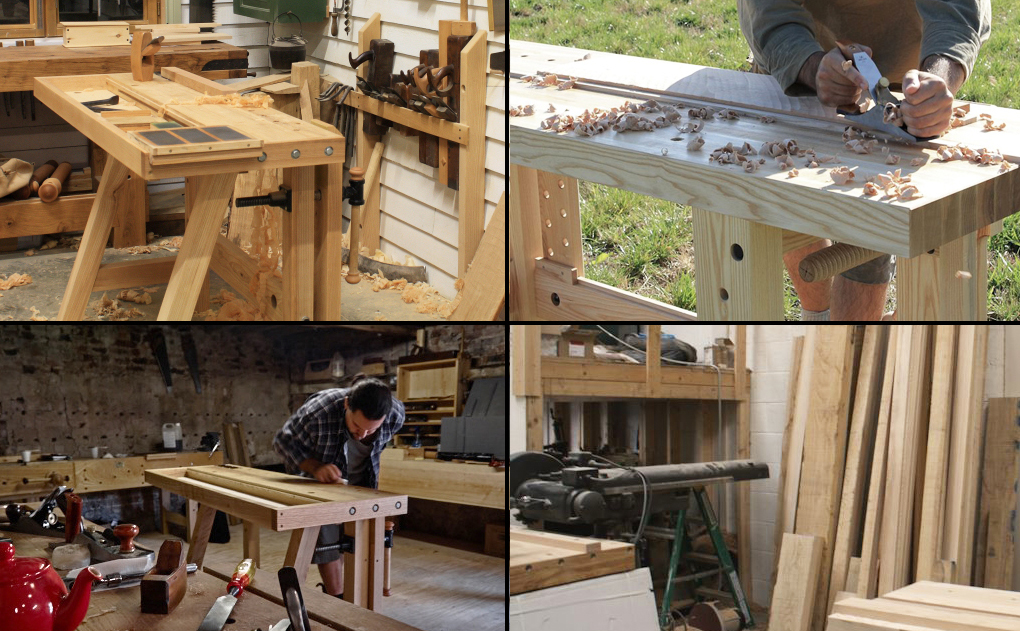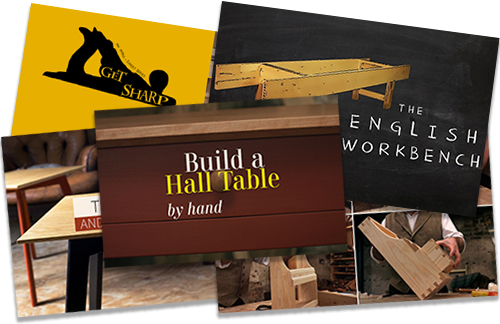What is a gnat’s nadger?
It’s something very small. Smaller than a 1/64″?
Smaller than I would care to measure.
If you’re getting any smaller then it’s a gnat’s cock hair.

You may see this as being annoyingly vague, or perhaps it makes me sound a bit simple?
I find it’s necessary for this type of measurement not to be prescriptive. Not only because I have no interest or need in figuring out callipers, feeler gauges or the like, but because when working with hand tools only, if things get this small then it’s unlikely that we could be exacting. More often it will need to be judged by feel, sight or sound since the measurement is so dependant on the specific situation.
Woodworking With Hand Tools Only
Woodworking by hand is not engineering. Aim for too tight a tolerance with your thicknessing and you’ll only be dismayed to see it has moved after you’ve polished off your pot of tea.
It interested me when I read a bit of Moxon’s observations on planing. He described the shavings from a fore plane as the thickness of an “old coined shilling”, or an “old groat” if the wood was harder or the grain difficult. We consider this to be in the region of a strong or slack 1/32″. So pretty heavy.
Another point from Moxon was the lack of winding sticks in the prepping process. I rarely use winding sticks and have to admit I’ve always felt inferior for it, since I’m sure it makes me sound rough. Moxon states to use your eye and a ruler. Eye and the plane sole works for me.
Hefty shavings and a lack of winding sticks, is this crude? It’s certainly not precision engineering. Nor is it slow.
This is hand tool woodworking.
And as my mother always said to me, “If you go looking for problems, you will find them”.
We teach a traditional yet modern approach to woodworking.
Traditional because we use hand tools, but I think of it as modern because we’re not about re-creating history.
I seek methods that are the most efficient and productive for the individual maker.
If you’re new to hand tools, then you’ll get a better understanding of this mindset by having a read about the shortcuts you can take when cutting mortice and tenons by hand.
Or you might be asking, do you need a bandsaw?
And if you’re looking to set up your tool kit, here’s my guide for everything you need to start woodworking with hand tools (there’s a lot less than you might be thinking).

![Simple Work Holding For Ploughing Grooves [Without a Tail Vice]](https://www.theenglishwoodworker.com/wp-content/uploads/2022/07/workholding-without-tail-vice-copy.jpg)



Great post, Richard. Thicknessing is the most intimidating part for me and you just eased my mind considerably. Thanks!
Would love if you made a video on thicknessing – your approach to hand tool woodworking is the most practical and helpful that I’ve found.
Thanks Ilya,
Yes, hand preparing can seem like a bit of a dark art. Through the years of woodworking I’ve actually come to love the process (don’t know why!). We’ve got a few things in the pipeline for prepping, the challenge has been in putting something systematic together but I’ve come up with a bit of a formula that’s working a treat. I’m sure we’ll be getting to it soon.
Preach it brother!
🙂
I have a set of calipers in my shop. I use them when I’m trying to figure out the diameter of a piece of dowel. Or the size of the bit I think I might need to use to drill a hole for said dowel when I forget the numbering system for the brace bits I’m using.
That’s about it, anymore, honestly. With a greater focus on hand tools in my shop, I’m trying very hard to not worry about what the actual length or width or thickness of a piece of wood is, as long as I mark that distance on the joining piece properly.
When cutting something to size, I’m training myself to present the material to the opening and mark it straight from there.
I think measurements are a crutch, a crutch that many of us rely on too much. But it takes a determined effort to throw away that crutch and walk on your own, without the yard stick or tape measure or calipers.
I’m getting there. Every day a little closer, every project a little more free from the confines of how we think we’re supposed to do things in the shop.
And one of these days I’ll memorize the numbering system for my brace bits and reduce my caliper use by half!
Many thanks, beautifully written.
The need to seek perfection is a human condition and overcoming it is naturally difficult.
You sound very much like you’re getting there.
Why not measure your bits once and engrave the dimension on it?
It seems that in the USA you like to make things complicated with your gauge systems, screw numbers, bit numbers and dimensional lumber where the real dimensions are different, etc. Why not indicate the real dimension of things (in imperial if you like it)?
Sylvain
Truer words were never spoken sir. Had to look up nadgers to be sure I got the reference right. You know us colonials….
Keep it coming man. Vic
Cheers Vic, was cock hair clear enough?! 😉
I recently made the switch from sighting horizontally down the length of the board (with sticks or with naked eyeballs) to sighting vertically down to the surface of the board. “How does that work?” you may ask. I use a torpedo level first at one end of the board….then at the other. If the edge of each bubble doesn’t reveal a gnat’s cock hair’s difference in position from the bubble at the opposite end, then I know each end of the board is in the same plane. (You can use two torpedo levels if you suffer from short term memory loss.) I then check at various points in between the two ends of the board to verify that they are in that same plane as well, but that’s probably unnecessary, since I’ve yet to find any variation when running the test.
Very interesting stuff Larry, I always enjoy creative ways. I’ll take the two levels, my short term memory is shot!
Two levels would work if the board is horizontal and the levels are accurate. With one level, you just have to verify that the slope is the same and in the same direction. You must also take care that if extremity A of your level was pointing in one direction for the first measurement ( your shop door for instance), it points to the same direction for the measurement on the other end of the board. With a single level, the only necessary quality of the level is giving repeatable indications.
Sylvain
I recently watched an online woodworker – who will remain nameless – measure a joint to what to me seemed like a insane degree of accuracy. I have just finished making several pieces and the only measuring I did was to dimension the original stock. Mortise and tenon widths were taken from the width of the chisel and the size of the stock.
I use my index finger as the feeler gauge and anything greater than 1/64″ is IMHO pointless since the wood is in constant ‘flux’ with the seasons and fittings to such a degree of accuracy are just going to frustrate. As you say Richard – this woodworking not engineering.
A lot of sense spoken there Michael. Just because we don’t care for an exact measurement doesn’t mean we aren’t working precisely.
Richard, Spot on truth with your post. My
Father was a machinist and built everything from our home, to sailboats, kitchen cabinets, mahogany display shelves and even a beautiful and functional 4×5 camera. I never saw him use any winding sticks because he did not own any, and his wood working projects still had very tight, uniform tolerances.. Everything woodworking he did was by standard measuring rulers,squares etc, and by eye and feel just as you do. (Micrometers and calipers etc were for his machinist work) Same goes for me in my shop, as he was my early mentor and taught me well.
Cheers,
Mike
Thanks Mike for the lovely insight. An engineer that left his callipers at the mill, you don’t hear much of that today!
I’m not disagreeing with you Richard, I wouldn’t dare. I still stumble by on crutches, measured in mm.
However, the gnat’s nadger for the setting back of the cap iron on my smoothing plane has been giving me some grief. I’m beginning to think that the pressure of the cap iron is bending the thin edge of the sharp end? Anyhow, with the cap iron too close, the plane becomes hard to push and seems less sharp, and I’ve revised my practice on that and backed it off somewhat. It might even be a millimeter.
I agree that this level of measurement is not good woodworking, make it fit, or fit for purpose, not some spurious size.
Hi Ian, disagree all you like 😉
In particular feel free to shout out if you’re struggling with something because chances are you’re not alone.
Are you using a plane with a tightly set mouth? It can be best to open the mouth up while you get a feel for this as it takes away the chance that it’s causing a clog.
Set that cap iron as close as you feel comfortable to at first, try it on some awkward grain. If you’re not happy with the tear out, try tapping the cap iron a little closer and try again. Too close and too far are not all that far apart.
Too close means that your shavings are looking like crinkled crisps. Too far, well are you getting tear? As a final question, what sort of plane are you using?
Cheers.
Richard.
Your Mother is a wise woman. Be thankful
Be Prosperous.
JW. 🙂
I’ll have to tell her that John, she’ll be chuffed!
I don’t think abandoning tapes, rulers, micrometers, and such means sloppyor inaccurate work. As a whippersnapper, I learned to use story poles or story sticks to do jobsite measurement and shop layout. I’ve had several of the new breed of machinists in wood come to me to solve problems over the years. They are usually amazed to find I do it with sticks, sectors (thank you Jim Tolpin), and dividers to solve design and measurement questions. I cann hardly believe the plethora of measuring devices marketed to today’s woodworkers who mistakenly believe that their use will improve shop outcomes. We should trust our eyes and fingers more than we do.
Eyes, fingers and sticks. I couldn’t agree more.
Good thing I saw this post as I was on my way to town to buy digital calipers. This saved me some money that I can use for wood. Thanks.
What is wrong with “crinkled chips”?
I set all my iron/cap spacing about the same. About a mm.
Some give crinkles, others give the universally accepted tight curls.
Perhaps it is also a function of mouth opening?
Just last night I used a 6″ rule to test flatness on a 6″ x 24″ panel I glued up and trued – with a jack and a smoother, of course. If there’s no light, there’s no gap…
The whole time, I was sad I haven’t made any winding sticks. But I promise I WILL! Because I can’t possibly do decent surfacing work without them. Right? 😉
Known in Australia as “smaller than a bee’s dick ” cheers Peter
An engineering friend once told me he had wear on a metal shaft that he could feel with his finger and see with light, but was unable to measure with calipers or a micrometer. With experience a finger can feel better than half a “thou” or less, reflected light can see to an even finer degree.
I sometimes wonder about those who fret because the timber they have isn’t the exact measurement to that shown on the plan they downloaded. To me I just look at a photo to get the general idea of how the item is constructed and only measure to be sure I have enough material to make the item, whether that is by hand or machine. Ultimately it does’t matter what the exact measurement is, except for replacing something, fitting parts together either fixed or moving comes down to the feel. Pete
Just a teaser on a sector and its use. http://www.popularwoodworking.com/article/jim-tolpin’s-‘secret-of-the-sector’
Good stuff Richard. Charlesworth always said that perfection isn’t attainable, so we should aim for precision and therein lies the rub…how do you define ‘precision?’ The tolerances that a hand tool worker uses may be greater than someone who relies on decent machinery, for example Rob Ingham aims to work to +/- 0.1mm, but his work is almost all done in veneered board. His hand tools would fit in Helen’s apron pocket! Makers using solid timber need to work to a more generous margin with a ‘seat of the pants’ approach, Krenov perhaps being a prime example. I think we have two extremes, the ‘engineered’ and ‘artisan’ approach and I suspect that most people fall somewhere in the middle, with perhaps a bias towards one way or the other.
Very good stuff (again). Was it mechanisation that shifted the perception of what is good or right? Machines do precision well, but their output lacks soul. And rulers (measuring devices) will often get in the way of design. The ‘imperfections’ are the signature of the hand-made – the old story of a certain fine Persian (I think) rug where the makers always put one ‘mistake’ in, because only God is allowed to be perfect.
Precision and tolerance must be fit for the purpose. If the dining table is a few cm longer oer shorter, it will not affect its function. If the four legs don’ fall exactly on the four corners of a rectangle, nobody will care. The tolerance of the joinery must of course be higher to ensure a good glue join.
On the other side, if you install (Ikea) kitchen modules, you expect all the modules to have tight tolerances so that they align correctly for aesthetic reasons.
In metal work there is no such a thing as “exact dimension”. Consider a rod/axle in a hole, the tolerance will be different if you want the rod to be fixed, sliding or turning in the hole. You also have to take into account environmental conditions. Consider an aircraft sitting for hours on a hot apron and then flying at an altitude where the temperature is minus 50°C.
Trying do do everything to +/- 0.1mm is not engineering. By the way 0.1 mm on a length of 1m is a much tighter tolerance then 0.1mm on 10 cm.
I would think trying to do things exactly is a misconception originating in school.
Sylvain
hy richard,
here in the southwest of germany (swabia) we have a word for something very small:
we call it “Muggeseggele”. A “mugg” is a fly and a “seggel” is a word for the male sex organ. (also used as an insult) so basicly the same as in english.
stefan
Fast ebsenso gross wie ein Fotzenhaar.
Too many of us have forgotten – or slept through class – the differences among “accuracy,” “precision,” and “trueness.”
In woodworking, do we really care if the mortise is truly 1/4″? (That’s asking if it’s “accurate,” or in some contexts, if it’s “true.”) The reality is, we don’t really care at all. What we care about is whether the tenon is too tight and splits the piece or too loose so the joint falls apart or just right and makes a sound joint. Accuracy, trueness and precision don’t matter at all. Just a sound joint matters.
There are other contexts in woodworking where “sameness” of dimensions are of some importance.
To stay with the mortise and tenon context, consider a frame and panel door or a cabinet face frame. If the distance between tenon shoulders isn’t equal, the structure won’t be square and you’ll be doing a messy fix of some kind to fit the thing in place. Making that distance equal for the rails and equal for the styles is a basic requirement of good work. And that’s precision. You don’t much care if the distance is some pre-defined measurement with tight tolerances of accuracy. You only care if the pieces are the same in that key dimension.
None of your projects in the normal range of woodworking needs be accurate or true. On the other hand, if you fail to work to adequate precision on the key parts, your project runs the risk of coming out poorly. That’s the difference between a measuring rule (or tape measure) and a story stick.
Richard may not measure a lot of things, but he certainly works with a rather high level of precision when it matters.
This post recalls the saying of a Colne boat-builder ” A lot of the job is to get everything fair, because a measurement is a measurement and it can lie, but fairness is fairness. They always reckon fairness supersedes a measurement, because you can be given a measurement of something and it literally goes like a dog’s lead, but if it’s fair, it looks fair, and it is fair.”
A good notion, I believe.
I recall Ray Speck chiding a student boatbuilder who was agonizing over the fit of some part, “It’s only a boat!”